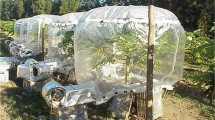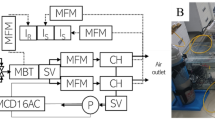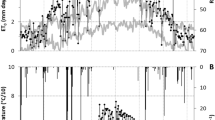Abstract
There are limited studies available that have investigated the effects of different levels of water supply on the whole-plant gas exchange dynamics. The latter is related to the difficulty in measuring whole-canopy carbon fixation and water consumption, especially in field conditions. Whole-plant chambers can measure these fluxes, therefore the aims of this work were (i) to determine the relationship between whole-plant gas exchange compared to single leaf gas exchange; (ii) to validate whole-canopy chamber measurements using sap flow probes; (iii) to measure the effect of soil water availability on water use efficiency calculated from gas exchange measured using whole-plant chambers. For these purposes, an experiment was carried out during the 2014 season in an experimental vineyard using six-years-old plants of cv. Grenache. Two irrigation regimes were established, moderate irrigation (50 % ETo) and non-irrigation. Carbon fixation and transpiration were measured using whole-plant chambers at veraison and pre-harvest. Simultaneously, leaf gas exchange was measured at different canopy positions during the day in order to compare those measurements with the whole-plant chamber data. In parallel, sap flow measurements were continuously recorded using heat balance probes. Results showed that CO2 fixation measured at noon in sun exposed leaves oriented to the south presented the highest correlation coefficient with whole plant chamber data. Whole-plant transpiration measured with whole-plant chambers was slightly higher compared to the estimated from sap flow data in both irrigated and non-irrigated plants. In general intensive leaf-level measurements do not completely reflect the whole plant physiology, due to variability of leaf to leaf environmental conditions and plant regulation of gas exchange.








Similar content being viewed by others
References
Alarcón JJ, Domingo R, Green S, Sanchez-Blanco MJ, Rodríguez P, Torrecillas A (2000) Sap flow as an indicator of transpiration and the water status of young apricot trees. Plant Soil 227:77–85
Baker JM, Van Bavel CH (1987) Measurement of mass flow of water in the stems of herbaceous plants. Plant Cell Environ 10:777–782
Baldocchi DD, Amthor JS (2001) Canopy photosynthesis: history, measurements and models. In: Roy J, Saugier B, Mooney H (eds) Terrestrial Global Productivity: Past Present and Future. Academic Press, San Diego, p 31
Braun P, Schmid J (1999) Sap flow measurements in grapevine (Vitis vinifera L.) Stem morphology and use of the heat balance method. Plant Soil 215:39–45
Calo A, Giorgessi F, Sansone L, Tomasi D, Zerbi G (1999) Recherches sur le rapport entre le flux de seve, la transpiration et la vigueur dans la vigne selon le mode de conduite. Vitis 38:7–13
Charles-Edwards DA (1982) Physiological Determinants of Crop Growth. Academic Press, Sydney
Chaves MM, Zarrouk O, Francisco R, Costa JM, Santos T, Regalado AP, Rodrigues ML, Lopes CM (2010) Grapevine under deficit irrigation: hints from physiological and molecular data. Ann Bot 105:661–676
Condon AG, Richards RA, Rebetzke GJ, Farquhar GD (2002) Improving intrinsic water-use efficiency and crop yield. Crop Sci 42:122–131
Correia MJ, Pereira JS, Chaves MM, Rodrigues ML, Pacheco CA (1995) ABA xylem concentrations determine maximum daily leaf conductance of field-grown Vitis vinifera L. plants. Plant Cell Environ 18:511–521
Dos Santos TP, Lopes CM, Lucilia Rodrigues M, de Souza CR, Maroco JP, Pereira JS, Silva JR, Chaves M (2003) Partial rootzone drying: effects on growth and fruit quality of fieldgrown grapevine (Vitis vinifera L.). Funct Plant Biol 30:663–671
Dragoni D, Lakso AN, Piccioni RM, Tarara J (2006) Transpiration of grapevines in the Humid Northeastern United States. Am J Enol Vitic 57:460–467
Eastham J, Gray S (1988) A preliminary evaluation of the suitability of sap flow sensors for use in scheluding vineyard irrigation. Am J Enol Vitic 49:171–176
Escalona J, Flexas J, Medrano H (2002) Drought effects on water flow, photosynthesis and growth of potted grapevines. Vitis 41:57–62
Escalona JM, Flexas J, Bota J, Medrano H (2003) Distribution of leaf photosynthesis and transpiration within grapevine canopies under different drought conditions. Vitis 42:57–64
Grace J, Lloyd J, Mcintyre J, Miranda A, Meir P, Miranda H, Moncrieff J, Massheder J, Wright I, Gash J (1995) Fluxes of carbon dioxide and water vapour over an undisturbed tropical forest in south-west Amazonia. Glob Change Biol 1:1–12
Intrieri C, Poni S, Rebucci B, Magnanini E (1997) Effects of canopy manipulations on whole-vine photosynthesis: results from pot and field experiments. Vitis 36:167–173
Intrigliolo DS, Lakso AN, Piccioni RM (2009) Grapevine cv. ‘Riesling’ water use in the northeastern United States. Irrig Sci 27:253–262
Kalt-Torres W, Kerr PS, Usuda H, Huber SC (1987) Diurnal changes in maize leaf photosynthesis. Plant Physiol 83:283–288
Kull O, Jarvis PG (1995) The role of nitrogen in a simple scheme to scale up photosynthesis from leaf to canopy. Plant Cell Environ 18:1174–1182
Lascano RG, Baumhardt RL, Lipe WN (1992) Measurement of water flow in young grape-vines using the stem heat balance method. Am J Enol Vitic 49:693–700
Martorell S, Diaz-Espejo A, Tomás M, Pou A, El Aou-ouad H, Escalona JM, Vadell J, Ribas-Carbó M, Flexas J, Medrano H (2015) Differences in water use efficiency between two Vitis vinifera cultivars (Grenache and Tempranillo) explained by the combined response of stomata to hydraulic and chemical signals during water stress. Agric Water Manag 156:1–9
McCree KJ (1986) Whole-plant carbon balance during osmotic adjustment to drought and salinity stress. Aust J Plant Physiol 13:33–43
Medrano H, Escalona JM, Bota J, Gulías J, Flexas J (2002) Regulation of photosynthesis of C3 plants in response to progressive drought: the interest of stomatal conductance as a reference parameter. Ann Bot 89:895–905
Medrano H, Flexas J, Ribas-Carbó M, Gulías J (2010) Measuring water use efficiency in grapevines. In: Delrot S, Medrano H, Or E, Bavaresco L (eds) Methodologies and Results in Grapevine Research. Springer, New York, pp 123–134
Medrano H, Pou A, Tomás M, Martorell S, Gulias J, Flexas J, Escalona JM (2012) Average daily light interception determines leaf water use efficiency among different canopy locations in grapevine. Agric Water Manag 114:4–10
Medrano H, Tomás M, Martorell S, Flexas J, Hernández E, Rosselló J, Pou A, Escalona JM, Bota J (2015) From leaf to whole plant water use efficiency (WUE) in complex canopies: limitations of leaf WUE as selection target. Crop J 3:220–228
Merli MC, Gatti M, Galbignani M, Bernizzoni F, Magnanini E, Poni S (2015) Comparison of whole-canopy water use efficiency and vine performance of cv. Sangiovese (Vitis vinifera L.) vines subjected to post-veraison water deficit. Sci Hort 185:113–120
Miller DP, Howell GS, Flore JA (1997) Influence of shoot number and crop load on potted Chambourcin grapevines: whole-vine vs. single-leaf photosynthesis. Vitis 36:109–114
Morison JIL, Baker NR, Mullineaux PM, Davies WJ (2008) Improving water use in crop production. Philos Trans R Soc B 363:639–658
Mullins MG, Bouquet A, Williams LE (1992) Biology of the grapevine. Cambridge University Press, Cambridge
Norby R, Edwards N, Riggs J, Abner C, Wullschleger S, Gunderson C (1997) Temperature-controlled open-top chambers for global change research. Glob Change Biol 3:259–267
Peña JP, Tarara JM (2004) A portable whole canopy gas exchange system for several mature field-grown grapevines. Vitis 43:7–14
Petrie PR, Trought MC, Howell G, Buchan GD (2003) The effect of leaf removal and canopy height on whole-vine gas exchange and fruit development of Vitis vinifera L Sauvignon Blanc. Funct Plant Biol 30:711–717
Petrie PR, Trought MC, Howell GS, Buchan GD, Palmer JW (2009) Whole-canopy gas exchange and light interception of vertically trained Vitis vinifera L. under direct and diffuse light. Am J Enol Vitic 60:173–182
Poni S, Magnanini E, Rebucci B (1997) An automated chamber system for measurements of whole-vine gas exchange. HortScience 32:64–67
Poni S, Magnanini E, Bernizzoni F (2003) Degree of correlation between total light interception and whole-canopy net CO2 exchange rate in two grapevine growth systems. Aust J Grape Wine Res 9:2–11
Poni S, Bernizzonia F, Civardia S, Gattia M, Porro D, Caminc F (2009) Performance and water-use efficiency (single-leaf vs. whole-canopy) of well-watered and half-stressed split-root Lambrusco grapevines grown in Po Valley (Italy). Agric Ecosys Environ 129:97–106
Poni S, Merli MC, Magnanini E, Galbignani M, Bernizzoni F, Vercesi A, Gatti M (2014) An Improved multi chamber gas exchange system for determining whole-canopy water-use. Am J Enol Vitic 65:268–276
Popescu M, Popescu GC (2014) Diurnal changes in leaf photosynthesis and relative water content of grapevine. Curr Trends Nat Sci 3:74–81
Rodrigues ML, Chaves MM, Wendler R, David MM, Quick WP, Leegood RC, Stitt M, Pereira JS (1993) Osmotic adjustment in water stressed grapevine leaves in relation to carbon assimilation. Aust J of Plant Physiol 20:309–321
Rosati A, Dejong TM (2003) Estimating photosynthetic radiation use efficiency using incident light and photosynthesis of individual leaves. Ann of Bot 91:869–877
Sakuratani T (1981) A heat balance method for measuring water flux in the stem of intact plants. J Agric Meteorol 37:9–17
Sánchez de Miguel P, Junquera P, De la Fuente M, Jiménez L, Linares R, Baeza P, Lisarrague JR (2011) Estimation of vineyard leaf area by linear regression. Span J Agric Res 9:202–212
Smith DM, Allen SJ (1996) Measurement of sap flow in plant stems. J Exp Bot 47:1833–1844
Tarara JM, Peña JEP, Keller M, Schreiner RP, Smithyman RP (2011) Net carbon exchange in grapevine canopies responds rapidly to timing and extent of regulated deficit irrigation. Funct Plant Biol 38:386–400
Tarara JM, Chaves B, Strik BC (2014) Grow tubes change microclimate and bush architecture but have little effect on bush bio-mass allocation at the end of the establishment year in blueberry. HortScience 49:596–602
Tomás M, Medrano H, Pou A, Escalona JM, Martorell S, Ribas-Carbó M, Flexas J (2012) Water-use efficiency in grapevine cultivars grown under controlled conditions: effects of water stress at the leaf and whole-plant level. Aust J Grape Wine Res 18:164–172
Williams LE, Araujo FJ (2002) Correlations among predawn leaf, midday leaf, and midday stem water potential and their correlations with other measures of soil and plant water status in Vitis vinifera. J Am Soc Hortic Sci 127:448–454
Acknowledgments
This work has been developed with financial support from the Spanish Ministry of Economy project AGL2014-54201-C4-1, and the financial assistance by University of Balearic Island for visiting professors stays. We are indebted to Dr. Pérez Peña, Dr. Prieto (INTA, Argentina), and Mr. Pep Sastre (University of Balearic Island) during construction and commissioning of whole plant chambers. We would like to thank Mr. Miquel Truyols and collaborators of the UIB Experimental Field which are supported by the UIB Grant 15/2015 for their support to our experiments. We want to thanks Dr. Fuentes for English revision.
Author information
Authors and Affiliations
Corresponding author
Additional information
José M. Escalona and Alicia Pou contributed equally to this work.
Electronic supplementary material
Below is the link to the electronic supplementary material.
Rights and permissions
About this article
Cite this article
Escalona, J.M., Pou, A., Tortosa, I. et al. Using whole-plant chambers to estimate carbon and water fluxes in field-grown grapevines. Theor. Exp. Plant Physiol. 28, 241–254 (2016). https://doi.org/10.1007/s40626-016-0073-7
Received:
Accepted:
Published:
Issue Date:
DOI: https://doi.org/10.1007/s40626-016-0073-7




